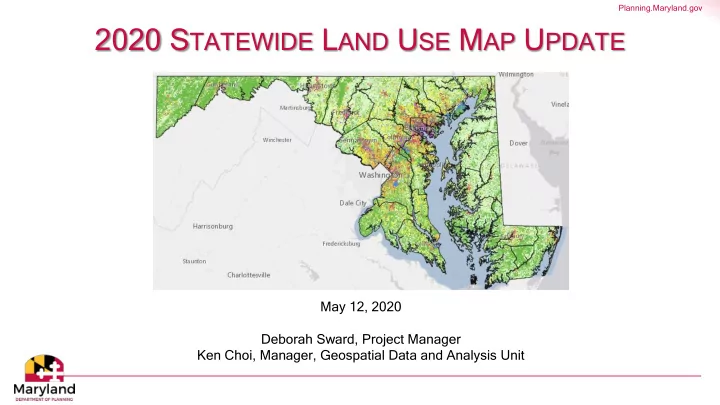

Planning.Maryland.gov 2020 S TATEWIDE L AND U SE M AP U PDATE May 12, 2020 Deborah Sward, Project Manager Ken Choi, Manager, Geospatial Data and Analysis Unit
Planning.Maryland.gov M EETING P URPOSE • Land use product overview • 2020 update process and potential methodology/classification revisions • Discussion • Gather additional ideas and feedback through post- webinar questionnaire
Planning.Maryland.gov 2010 L AND U SE L AND C OVER P RODUCT Webpage and Documentation: https://planning.maryland.gov/Pages/OurWork/landuse.aspx Data Download: https://planning.maryland.gov/Pages/OurProducts/DownloadFiles.aspx
Planning.Maryland.gov 2010 C LASSIFICATIONS Developed Land Remaining Undeveloped (Resource) Land or Water Very Low Density Residential (< 0.2 du/ac) Agriculture -Primarily Agriculture vs. Forest -Primarily Forest Water Wetland Low Density Residential (0.2-2 du/ac) Barren Medium Density Residential (2-8 du/ac) High Density Residential (8+ du/ac) Commercial Industrial Institutional Other Developed Lands • Major transportation facilities • Extractive • Open urban land For definitions see: https://planning.maryland.gov/Pages/OurWork/landuse.aspx
Planning.Maryland.gov
Planning.Maryland.gov E XAMPLE U SES THE L AND U SE M AP Planning Activity Use Comprehensive planning Calculate existing land use distribution Pollutant loading analyses Calculate loading based on rates by land use type Development capacity, land Where does development capacity preservation targeting, and land or pressure exist in undeveloped stability analyses areas? Transportation planning Trip generation/distribution NEPA Indirect and Cumulative Effects Analyses
Planning.Maryland.gov L AND U SE A ND L AND C OVER D ATASET V ARIATIONS Source: Maryland Department of Planning, 2010 Land Use Land Cover Source: Chesapeake Conservancy, 2013/2014 Land Cover
Planning.Maryland.gov 2020 M ETHODOLOGY U PDATES • Tools and Data: Vectorized parcel polygons attributed with tax parcel assessment data High-resolution land cover data (Chesapeake Conservancy) GIS license for raster analysis • Goals: Automate and standardize procedures to extent feasible Capture where development has occurred Balance land use detail and generalization Defer to others for undeveloped land use and land cover
Planning.Maryland.gov P OTENTIAL R EVISED C LASSIFICATIONS Urban (Developed) Land Uses Remaining Undeveloped (Resource) Land Very Low Density Residential (< 0.2 du/ac) Agriculture -Primarily Agriculture vs. Forest -Primarily Forest Water Wetland Low Density Residential (0.2-2 du/ac) Barren Medium Density Residential (2-8 du/ac) High Density Residential (8+ du/ac) Commercial Remove sub- Industrial classifications related to land cover or undeveloped Institutional land use Other Developed Lands • Major transportation facilities • Extractive • Open urban land
Planning.Maryland.gov P OTENTIAL R EVISED C LASSIFICATIONS Urban (Developed) Land Uses Remaining Undeveloped (Resource) Land Very Low Density Residential (< 0.2 du/ac) Agriculture -Primarily Agriculture vs. Forest -Primarily Forest Water Wetland Low Density Residential (0.2-2 du/ac) Barren Medium Density Residential (2-8 du/ac) High Density Residential (8+ du/ac) Commercial Possibly expand Industrial transportation Institutional classification to include Other Developed Lands additional roads. Possibly • Major transportation facilities classify entire right-of-way • Extractive as transportation • Open urban land
Planning.Maryland.gov P OTENTIAL R EVISED C LASSIFICATIONS Urban (Developed) Land Uses Remaining Undeveloped (Resource) Land Very Low Density Residential (< 0.2 du/ac) Undeveloped Resource Land Low Density Residential (0.2-2 du/ac) Medium Density Residential (2-8 du/ac) High Density Residential (8+ du/ac) Commercial Industrial Institutional Other Developed Lands • Transportation facilities • Extractive • Open urban land
Planning.Maryland.gov S TEP 1: C LASSIFY P ARCELS • Classified using tax parcel assessment data • Single-family residential density classified based on lot size Note: Image shows hypothetical example. Actual land uses may differ.
Planning.Maryland.gov S TEP 2: D ELINEATE U RBAN L AND U SES • Single-family residential uses follow parcel boundaries • Forest line assists in delineating other urban uses Large parcels only partially in use Helps distinguish between areas assessed for vs. in use
Planning.Maryland.gov Classified Parcel Generalized Tree Line Note: Image shows hypothetical example. Actual land uses may differ.
Planning.Maryland.gov S TEP 3: G ENERALIZE L AND U SES • Generalize residential density • Determine appropriate level of detail for nonresidential and potential ancillary uses Note: Images show hypothetical example. Actual land uses and generalization scheme may differ.
Planning.Maryland.gov D RAFT G ENERALIZATION S CHEME Land Use Generalization Scheme (Subject to Revision) •Multifamily residential Capture individual instances •Very low density residential single- family •Key institutions (schools, hospitals, government offices, etc.) •Single-family residential 5 clustered housing units or five acres Other developed uses (commercial, TBD industrial, institutional)
Planning.Maryland.gov S TEP 4: F INALIZE AND QC Review output against aerial imagery, 2010 map, and • supplemental sources Opportunity for county or local governments to review • Draft completion late 2020/early 2021 (subject to • adjustment) Final product will be in vector format and will be referred • to as a “Land Use” map
Planning.Maryland.gov A DDITIONAL C ONSIDERATIONS • Not directly comparable to 2010 map. Land use change estimates may be completed as second phase of project • Generalized map is not for parcel-scale analysis • Consider using product in conjunction with other datasets • Data sharing partnerships (mixed use, housing units per parcel, key institutions, etc.)
Planning.Maryland.gov D ISCUSSION Co Contact Us Us Deborah Sward, Project Manager deborah.sward@maryland.gov Ken Choi, Geospatial Data and Analysis Unit Manager ken.choi@maryland.gov Vis isit it Our W Websit ite https://planning.maryland.gov/Pages/OurWork/landuse.aspx Those registered for the webinar will receive a questionnaire by email to provide additional feedback on the statewide land use map. Thank you for participating!
Recommend
More recommend